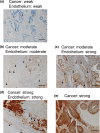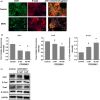High expression of the Notch ligand Jagged-1 is associated with poor prognosis after surgery for colorectal cancer
- PMID: 27589478
- PMCID: PMC5132269
- DOI: 10.1111/cas.13075
High expression of the Notch ligand Jagged-1 is associated with poor prognosis after surgery for colorectal cancer
Abstract
The importance of Notch signaling in colorectal cancer (CRC) carcinogenesis and progression has previously been presented. Increased expression of Jagged-1 (JAG1), a Notch ligand, in CRC has been revealed, but the detailed prognostic significance of JAG1 in CRC has not been determined. Protein expression of JAG1 was examined using immunohistochemistry in 158 CRC specimens. Expression of JAG1 and E-cadherin and their associations with clinicopathologic characteristics, overall survival (OS) and relapse-free survival (RFS) were evaluated. In vitro studies using compounds to regulate intracellular signaling and small interfering RNA to silence JAG1 were performed in a colon cancer cell line. JAG1 expression in cancerous tissues was weak, moderate or strong in 32%, 36% and 32% of specimens, respectively, and correlated with histologic type and T stage. In multivariate analysis, JAG1 expression, histologic type and lymphatic invasion independently correlated with OS and RFS. The combination of high JAG1 expression and low E-cadherin expression had an additive effect toward poorer OS and RFS compared with the low JAG1/high E-cadherin expression subtype. A significant correlation between JAG1 expression and KRAS status was detected in groups stratified as high E-cadherin expression. In vitro studies suggested that RAS-MEK-MAP kinase and the Wnt pathways positively regulated JAG1 expression. Gene silencing with siJAG1 indicated that JAG1 promotes the transition from epithelial to mesenchymal characteristics and cell growth. High expression of JAG1 is regulated by various pathways and is associated with poor prognosis through promoting the epithelial to mesenchymal transition and cell proliferation or maintaining cell survival in CRC.
Keywords: Colorectal cancer; JAG1; Notch; epithelial-mesenchymal transition; survival rate.
© 2016 The Authors. Cancer Science published by John Wiley & Sons Australia, Ltd on behalf of Japanese Cancer Association.
Figures






Similar articles
-
LncRNA UCA1/miR-124 axis modulates TGFβ1-induced epithelial-mesenchymal transition and invasion of tongue cancer cells through JAG1/Notch signaling.J Cell Biochem. 2019 Jun;120(6):10495-10504. doi: 10.1002/jcb.28334. Epub 2019 Jan 11. J Cell Biochem. 2019. PMID: 30635938
-
miR-598 inhibits metastasis in colorectal cancer by suppressing JAG1/Notch2 pathway stimulating EMT.Exp Cell Res. 2017 Mar 1;352(1):104-112. doi: 10.1016/j.yexcr.2017.01.022. Epub 2017 Feb 1. Exp Cell Res. 2017. PMID: 28161537
-
N-cadherin, a novel prognostic biomarker, drives malignant progression of colorectal cancer.Mol Med Rep. 2015 Aug;12(2):2999-3006. doi: 10.3892/mmr.2015.3687. Epub 2015 Apr 27. Mol Med Rep. 2015. PMID: 25936636
-
The oncogenic role of Jagged1/Notch signaling in cancer.Biomed Pharmacother. 2020 Sep;129:110416. doi: 10.1016/j.biopha.2020.110416. Epub 2020 Jun 25. Biomed Pharmacother. 2020. PMID: 32593969 Review.
-
The notch ligand JAGGED1 as a target for anti-tumor therapy.Front Oncol. 2014 Sep 25;4:254. doi: 10.3389/fonc.2014.00254. eCollection 2014. Front Oncol. 2014. PMID: 25309874 Free PMC article. Review.
Cited by
-
LncRNA LINC00461 Promotes Colorectal Cancer Progression via miRNA-323b-3p/NFIB Axis.Onco Targets Ther. 2019 Dec 17;12:11119-11129. doi: 10.2147/OTT.S228798. eCollection 2019. Onco Targets Ther. 2019. PMID: 31908480 Free PMC article.
-
Cell cycle arrest is an important mechanism of action of compound Kushen injection in the prevention of colorectal cancer.Sci Rep. 2022 Mar 14;12(1):4384. doi: 10.1038/s41598-022-08336-4. Sci Rep. 2022. PMID: 35288618 Free PMC article.
-
Research Progress of Epithelial-mesenchymal Transition Treatment and Drug Resistance in Colorectal Cancer.Technol Cancer Res Treat. 2022 Jan-Dec;21:15330338221081219. doi: 10.1177/15330338221081219. Technol Cancer Res Treat. 2022. PMID: 35435774 Free PMC article. Review.
-
Notch Signaling Pathway in Cancer-Review with Bioinformatic Analysis.Cancers (Basel). 2021 Feb 12;13(4):768. doi: 10.3390/cancers13040768. Cancers (Basel). 2021. PMID: 33673145 Free PMC article.
-
Notch-Jagged1 signaling and response to bevacizumab therapy in advanced colorectal cancer: A glance to radiomics or back to physiopathology?Front Oncol. 2023 Feb 28;13:1132564. doi: 10.3389/fonc.2023.1132564. eCollection 2023. Front Oncol. 2023. PMID: 36925919 Free PMC article.
References
-
- Santagata S, Demichelis F, Riva A et al JAGGED1 expression is associated with prostate cancer metastasis and recurrence. Cancer Res 2004; 64: 6854–7. - PubMed
-
- Purow BW, Haque RM, Noel MW et al Expression of Notch‐1 and its ligands, Delta‐like‐1 and Jagged‐1, is critical for glioma cell survival and proliferation. Cancer Res 2005; 65: 2353–63. - PubMed
-
- Reedijk M, Odorcic S, Chang L et al High‐level coexpression of JAG1 and NOTCH1 is observed in human breast cancer and is associated with poor overall survival. Cancer Res 2005; 65: 8530–7. - PubMed
MeSH terms
Substances
LinkOut - more resources
Full Text Sources
Other Literature Sources
Medical
Miscellaneous

